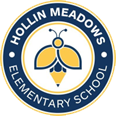School Innovation & Improvement Plan
Outcome goals for this academic school year
2024-2025 SIIP At a Glance
Hollin Meadows Elementary School
Region 3
Jasibi Crews, Principal
Area: Reading
Goals:
- The percentage of students in grades K-3 meeting or exceeding VALLSS screener benchmarks will increase by 5 percentage points from fall 2024 to spring 2025.
- The percentage of students who pass the Reading SOL in grades 3-6 will increase from 70% passing to 75% passing from school year 2023-2024 to 2024-2025.
Strategy 1:
Increase efficiency of instructional delivery to ensure all students have daily access to all components of the language arts block as outlined in the new core curriculum.
- Job-embedded professional development through Lesson study (co-planning, observation and reflection) to support new resource implementation.
- Data dialogues in collaborative teams analyzing common assessments and focused on guiding Tier 1 decision making.
- Data dialogues in collaborative teams to connect academic growth with student engagement.
Strategy 2:
Increase teacher content knowledge of evidence-based literacy instruction aligned with science-based reading research to improve implementation of new core curriculum.
- Job-embedded professional development throughout the school year for each of the required 9 VDOE Training Modules for teachers K-6.
- Teacher led discussions in collaborative teams on science based reading research and implications for teaching.
- Increase communication between teachers and parents regarding the implementation of the new Benchmark Curriculum based on science-based reading research.
Area: Math
Goals:
- By June 2025 on the Math SOL, the unadjusted pass rate of all students in grades 3-6 will increase by 5%.
- All students in grades 1-2 scoring on or above grade level will increase by 5% as measured by the math iReady.
Strategy 1:
Improve teachers’ implementation of Framework for Engaging & Student-Centered Mathematics Instruction.
- Job-embedded professional development such as lab sites, lesson studies or hybrids to support teachers with evidence-based and research based practices
- Intentionally using the data cycle to analyze common assessment results to identify and implement effective teaching practices to reteach or intervene.
- Intentionally using the data cycle to analyze common assessment results to identify and implement effective teaching practices to reteach or intervene.
Strategy 2:
Improve systems for communicating with families about math course pathways through 12th grade.
- Use our parent liaison to support home-school communication.
- Communicate with our parents related to tier 3 supports and growth from the supports.
- Implement parent trainings in order for parents to experience math instruction.
Area: Chronic Absenteeism
Goal:
By June 2025, the chronically absent student subgroup will decrease from 17% to 15% or less.
Strategy:
Implement practices to recognize good and improved attendance to reinforce attendance and strengthen student and family engagement.
- Monitor our new school bus service usage.
- Develop family workshops on various needs identified through family communication and input.
- Identify students who are chronically absent, support and educate families about the importance of attendance, and provide resources as needed.

